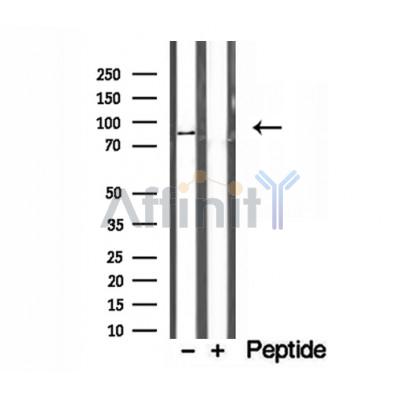AFG3L2 Antibody - #DF12186
| Product: | AFG3L2 Antibody |
| Catalog: | DF12186 |
| Description: | Rabbit polyclonal antibody to AFG3L2 |
| Application: | WB IHC |
| Reactivity: | Human, Mouse, Rat |
| Prediction: | Pig, Bovine, Sheep, Dog, Chicken |
| Mol.Wt.: | 80-90 kDa; 89kD(Calculated). |
| Uniprot: | Q9Y4W6 |
| RRID: | AB_2844991 |
Related Downloads
Protocols
Product Info
*The optimal dilutions should be determined by the end user. For optimal experimental results, antibody reuse is not recommended.
*Tips:
WB: For western blot detection of denatured protein samples. IHC: For immunohistochemical detection of paraffin sections (IHC-p) or frozen sections (IHC-f) of tissue samples. IF/ICC: For immunofluorescence detection of cell samples. ELISA(peptide): For ELISA detection of antigenic peptide.
Cite Format: Affinity Biosciences Cat# DF12186, RRID:AB_2844991.
Fold/Unfold
AFG3 (ATPase family gene 3, yeast) like 2; AFG3 ATPase family gene 3 like 2 (yeast); AFG3 ATPase family gene 3 like 2; AFG3 like protein 2; AFG3-like protein 2; AFG32_HUMAN; AFG3L2; ATPase family gene 3 like 2; ATPase family gene 3 yeast; EC 3.4.24.-; FLJ25993; Paraplegin like protein; Paraplegin-like protein; SCA28; Spinocerebellar ataxia 28;
Immunogens
A synthesized peptide derived from human AFG3L2, corresponding to a region within C-terminal amino acids.
- Q9Y4W6 AFG32_HUMAN:
- Protein BLAST With
- NCBI/
- ExPASy/
- Uniprot
MAHRCLRLWGRGGCWPRGLQQLLVPGGVGPGEQPCLRTLYRFVTTQARASRNSLLTDIIAAYQRFCSRPPKGFEKYFPNGKNGKKASEPKEVMGEKKESKPAATTRSSGGGGGGGGKRGGKKDDSHWWSRFQKGDIPWDDKDFRMFFLWTALFWGGVMFYLLLKRSGREITWKDFVNNYLSKGVVDRLEVVNKRFVRVTFTPGKTPVDGQYVWFNIGSVDTFERNLETLQQELGIEGENRVPVVYIAESDGSFLLSMLPTVLIIAFLLYTIRRGPAGIGRTGRGMGGLFSVGETTAKVLKDEIDVKFKDVAGCEEAKLEIMEFVNFLKNPKQYQDLGAKIPKGAILTGPPGTGKTLLAKATAGEANVPFITVSGSEFLEMFVGVGPARVRDLFALARKNAPCILFIDEIDAVGRKRGRGNFGGQSEQENTLNQLLVEMDGFNTTTNVVILAGTNRPDILDPALLRPGRFDRQIFIGPPDIKGRASIFKVHLRPLKLDSTLEKDKLARKLASLTPGFSGADVANVCNEAALIAARHLSDSINQKHFEQAIERVIGGLEKKTQVLQPEEKKTVAYHEAGHAVAGWYLEHADPLLKVSIIPRGKGLGYAQYLPKEQYLYTKEQLLDRMCMTLGGRVSEEIFFGRITTGAQDDLRKVTQSAYAQIVQFGMNEKVGQISFDLPRQGDMVLEKPYSEATARLIDDEVRILINDAYKRTVALLTEKKADVEKVALLLLEKEVLDKNDMVELLGPRPFAEKSTYEEFVEGTGSLDEDTSLPEGLKDWNKEREKEKEEPPGEKVAN
Predictions
Score>80(red) has high confidence and is suggested to be used for WB detection. *The prediction model is mainly based on the alignment of immunogen sequences, the results are for reference only, not as the basis of quality assurance.
High(score>80) Medium(80>score>50) Low(score<50) No confidence
Research Backgrounds
ATP-dependent protease which is essential for axonal and neuron development. In neurons, mediates degradation of SMDT1/EMRE before its assembly with the uniporter complex, limiting the availability of SMDT1/EMRE for MCU assembly and promoting efficient assembly of gatekeeper subunits with MCU. Required for the maturation of paraplegin (SPG7) after its cleavage by mitochondrial-processing peptidase (MPP), converting it into a proteolytically active mature form (By similarity). Required for the maturation of PINK1 into its 52kDa mature form after its cleavage by mitochondrial-processing peptidase (MPP).
Upon import into the mitochondrion, the N-terminal transit peptide is cleaved to generate an intermediate form which undergoes autocatalytic proteolytic processing to generate the proteolytically active mature form.
Mitochondrion. Mitochondrion inner membrane>Multi-pass membrane protein.
Ubiquitous. Highly expressed in the cerebellar Purkinje cells.
In the N-terminal section; belongs to the AAA ATPase family.
In the C-terminal section; belongs to the peptidase M41 family.
Restrictive clause
Affinity Biosciences tests all products strictly. Citations are provided as a resource for additional applications that have not been validated by Affinity Biosciences. Please choose the appropriate format for each application and consult Materials and Methods sections for additional details about the use of any product in these publications.
For Research Use Only.
Not for use in diagnostic or therapeutic procedures. Not for resale. Not for distribution without written consent. Affinity Biosciences will not be held responsible for patent infringement or other violations that may occur with the use of our products. Affinity Biosciences, Affinity Biosciences Logo and all other trademarks are the property of Affinity Biosciences LTD.


